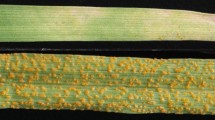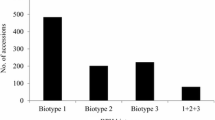Abstract
An introgression line derived from an interspecific cross between Oryzasativa and Oryza officinalis, IR54741-3-21-22 was found to beresistant to an Indian biotype of brown planthopper (BPH). Genetic analysisof 95 F3 progeny rows of a cross between the resistant lineIR54741-3-21-22 and a BPH susceptible line revealed that resistance wascontrolled by a single dominant gene. A comprehensive RAPD analysisusing 275 decamer primers revealed a low level of (7.1%) polymorphismbetween the parents.RAPD polymorphisms were either co-dominant (6.9%), dominant forresistant parental fragments (9.1%) or dominant for susceptible parentalfragments (11.6%). Of the 19 co-dominant markers, one primer,OPA16, amplified a resistant parental band in the resistant bulk and asusceptible parental band in the susceptible bulk by bulked segregantanalysis. RAPD analysis of individual F2 plants with the primerOPA16 showed marker-phenotype co-segregation for all, with only onerecombinant being identified. The linkage between the RAPD markerOPA16938 and the BPH resistance gene was 0.52 cM in couplingphase. The 938 bp RAPD amplicon was cloned and used as a probe on122 Cla I digested doubled haploid (DH) plants from aIR64xAzucena mapping population for RFLP inheritance analysis and wasmapped onto rice chromosome 11. The OPA16938 RAPD markercould be used in a cost effective way for marker-assisted selection of BPHresistant rice genotypes in rice breeding programs.
Similar content being viewed by others
References
Athwal, D.S., M.D. Pathak, E.H. Bacalangco & C.D. Pura, 1971. Genetics of resistance to brown planthopper and green leafhopper in Oryza sativa L. Crop Sci 11: 747-750.
Beaumont, V.H., J. Mantet, T.R. Rocheford & J.M. Widholm, 1996. Comparison of RAPD and RFLP markers for mapping F2 generations in Maize (Zea mays). Theor Appl Genet 93: 606-612.
Ford, R., E.C.K. Pang & P.W.J. Taylor, 1999. Genetics of resistance to ascochyta blight (Ascochyta lentis) of lentil and the identification of closely linked RAPD markers. Theor Appl Genet 98: 93-98.
Huang, N., P. Arnold, T. Mew, G. Magpantay, S. McCouch, E. Guiderdoni, J. Xu, P. Subudhi, R. Angeles & G.S. Khush, 1997. RFLP mapping of isozymes, RAPD and QTLs for grain shape, brown planthopper resistance in a doubled haploid rice population. Mol Breed 1: 1-8.
Ishii, T., D.S. Brar, D.S. Multani & G.S. Khush, 1994. Molecular tagging of genes for brown planthopper resistance and earliness introgressed from O. australiensis into cultivated rice, O. sativa. Genome 37: 217-221.
Jena, K.K. & G.S. Khush, 1990. Introgression of genes from Oryza officinalis Well ex Watt. to cultivated rice, O. sativa L. Theor Appl Genet 80: 737-745.
Jena, K.K. & G. Kochert, 1991. Restriction fragment length polymorphism analysis of CCDD genome species of the genus Oryza L. Plant Mol Bol 16: 831-839.
Jena, K. K., G.S. Khush & G. Kochert, 1992. RFLP analysis of rice (Oryza sativa L.) introgression lines. Theor Appl Genet 84: 608-616.
Jena, K.K., G.S. Khush & G. Kochert, 1994. Comparative RFLP mapping of a wild rice, Oryza officinalis, and cultivated rice, O. sativa. Genome 37: 382-389.
Jena, K.K., I.C. Pasalu, K. Krishnaiah & G.S. Khush, 1998. A RAPD marker for the gene conferring resistance to Indian biotype of BPH. Rice Genet Newsl 15: 133-134.
Jeon, Y.H., S.N. Ahn, H.C. Choi, T.R. Hahn & H.P Moon, 1999. Identification of a RAPD marker linked to a brown planthopper resistance gene in rice. Euphytica 107: 23-28.
Kabir, M.A. & G.S. Khush, 1988. Genetic analysis of resistance of brown planthopper in rice, Oryza sativa L. Plant Breed 100: 54-58.
Kalode, M.B. & T.S. Krishna, 1979. Varietal resistance to brown planthopper in India. In: Brown Planthopper: Threat to Rice Production in Asia. International Rice Research Institute, Manila, Philippines, pp. 369.
Khush, G.S. & D.S. Brar, 1991. Genetics of resistance to insects in crop plants. Adv Agron 45: 223-274.
Khush, G.S., D.S. Brar & B. Hardy, 2001. Rice genetics from Mendel to functional genomics. Rice Genet IV: 3-25.
Kosambi, D.D., 1944. The estimation of map distances from recombination values. Ann Eugen 12: 172-175.
Lakshminarayana, A. & G.S. Khush, 1997. New genes for resistance to brown planthopper in rice. Crop Sci 17: 96-100.
Lander, E.S., P. Green, J. Abrahamson, A. Barlow, M.J. Daly, S.E. Lincoln & L. Newburg, 1987. MAPMAKER: An interactive computer package for constructing primary genetic linkage maps of experimental and natural populations. Genomics 1: 174-181.
Manninen, O.M., 2000. Associations between anther-culture response and molecular markers on chromosomes 2H, 3H and 4H of barley (Hordeum vulgare L.). Theor Appl Genet 100: 57-62.
Martin, G.B., J.G.K. Williams & S.D. Tanksley, 1991. Rapid identification of markers linked to a Pseudomonas resistance gene in tomato by using random primers and near isogenic lines. Proc Natl Acad Sci USA 88: 2336-2340.
McCouch, S.R., X. Chen, O. Panaud, S. Temnykh, Y. Xu, Y.G. Cho, N. Huang, T. Ishii & M. Blair, 1997. Microsatellite marker development, mapping and applications in rice genetics and breeding. Plant Mol Biol 35: 89-99.
Mei, M., C. Zhuang, R. Wan, J. Wu, W. Hu & G. Kochert, 1996. Genetic analysis and tagging of gene for brown planthopper resistance in indica rice. In: G.S. Khush (Ed.), Rice Genetics III, pp. 590-595. International Rice Research Institute, Manila, Philippines.
Michelmore, R.W., I. Paran & R.V. Kesseli, 1991. Identification of markers linked to disease resistance genes by bulked segregant analysis: A rapid method to detect markers in specific genomic regions by using segregating populations. Proc Natl Acad Sci USA 88: 9828-9832.
Mohan, M., S. Nair, A. Bhagwat, T.G. Krishna, M. Yano, C.R. Bhatia & T. Sasaki, 1997. Genome mapping, molecular markers and marker-assisted selection in crop plants. Mol Breed 3: 87-103.
Nair, S., J.S. Bentur, U. PrasadaRao & M. Mohan, 1995. DNA markers tightly linked to a gall midge resistance gene (Gm2) are potentially useful for marker-aided selection in rice breeding. Theor Appl Genet 91: 68-73.
Shimano, T., T. Inoue, B.A. Antonio, K. Iliromi, A. Shomura, S.Y. Lin, Y. Kuboki, Y. Nagamura, N. Kurata, M. Yano & T. Sasaki, 1995. Extensive conservation in linkage alignment of RFLP markers between rice chromosome 11 and 12. Plant Genome 3: 75.
Tanksley, S.D., N.D. Young, A.H. Paterson & M.W. Bonierbale, 1989. RFLP mapping in plant breeding: new tools for an old science. Bio / Technology 7: 257-264.
Urrea, C.A., P.N. Miklas, J.S. Beaver & R.H. Riley, 1996. A codominant randomly amplified polymorphic DNA (RAPD) marker useful for indirect selection of BGMV resistance in common bean. J Am Soc Hort Sci 121: 1035-1039.
Author information
Authors and Affiliations
Rights and permissions
About this article
Cite this article
Jena, K., Pasalu, I., Rao, Y. et al. Molecular tagging of a gene for resistance to brown planthopper in rice (Oryza sativa L.). Euphytica 129, 81–88 (2003). https://doi.org/10.1023/A:1021590025240
Issue Date:
DOI: https://doi.org/10.1023/A:1021590025240




